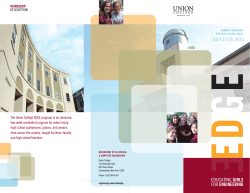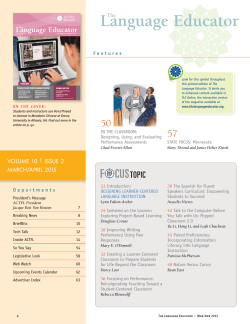
IDEA Item #11: âRelated course material to real life situationsâ
POD —IDEA Center Notes J U L Y 2 0 0 4 Michael Theall, Youngstown State University, Series Editor IDEA Item #11: “Related course material to real life situations” Michael Theall Youngstown State University Background There are many reasons for incorporating real-life situations into instruction. Foremost are that applications of theoretical material in real-life situations make content easier to understand and that the relevance of content is demonstrated by reallife examples. Relevance is a major component of many motivational models (1) (2) and particularly important if learners’ experiences can be used as a basis for new learning. Recent literature on brain function and learning (3) reinforces a constructivist view in which existing knowledge forms the foundation for incorporating new information into more complex and sophisticated schemas. Thus, if prior experience can be connected to new material in a meaningful way, that material can be more clearly understood and more easily learned. There is a caution, of course: that student misconceptions can interfere with new learning. Research on the dimensions of college teaching (5) also provides powerful evidence of the importance of connecting content to real-life situations. With respect to student achievement, the four most strongly correlated teaching dimensions are organization, clarity, perceived outcome, and stimulation of interest. As additional information, look at your scores on IDEA items #4 (demonstrating the significance of the subject), #6 (make clear how topics fit), #13 (introduce stimulating ideas), and #10 (explain material clearly). Item #11 correlates strongly with these items and with IDEA learning objectives dealing with gaining factual knowledge, principles and theories, learning to apply course material, developing specific professional skills, and values development. Helpful Hints It is always helpful to know about students’ prior experience and learning, and particularly so when misconceptions exist. Here, appropriate use of assessment techniques can help the instructor to determine the extent to which existing knowledge and experience can be effectively used, or whether alternative approaches are needed. Angelo and Cross (4) suggest techniques for determining not only factual knowledge, but also skills in analysis, synthesis, critical thinking, problem solving, and student attitudes and values. Many times, misconceptions are the result of a combination of misinformation and misinterpretation, but such errors can not simply be dismissed. Zull (3) strongly recommends that finding a way to use past experience is more effective than simply telling the student, “That’s wrong. The right answer is…”. Misconceptions don’t go away simply because we provide the right answers. However, with an understanding of the nature of students’ misconceptions, it is possible to help students reorganize existing knowledge and to help students reconstruct old ideas in new and appropriate ways. Zull (p.93) sums it up as follows: “First, prior knowledge is a fact….Second, prior knowledge is persistent….Third, prior knowledge is the beginning of new knowledge. It is always where all learners start. They have no choice.” Given this it seems not only wise, but necessary for teachers to make clear the relationships between prior knowledge/experience and new material. When course material is connected to real-life situations, the instructor can demonstrate logical organization: (“Today, as we discuss supply and demand I will show how theory X can be applied to solving problem Y. I’ve chosen this example because it provides a clear path to gaining a solid understanding of the basis for many economic decisions.”). Applications make content more clear and understandable: (“Now, let’s do this case study to see how and why this principle works”). Connecting content to a desired real-world outcome demonstrates practical value: (“This is the kind of project that you will have to carry out as professionals in the workplace”). Finally, making connections as above stimulates interest by getting students engaged in solving problems that interweave theory, applications, and recognizable tasks. Coincidentally, these four teaching dimensions (organization, clarity, perceived outcomes, and stimulation of interest) are also among the most powerful predictors of student ratings of teaching. It is easy to see how organization and clarity are related, and a logical structure makes it easier for students to know what is expected. The combination allows students to grasp the importance of the course and they are more easily motivated, more often engaged, and more frequently successful. Maryellen Weimer (6) notes that we need to: “...treat experiential knowledge more analytically and more objectively” (p. xiv) and she describes “learnercentered teaching” as a process that “…accepts, cultivates, and builds on the ultimate responsibility students have for learning” (p. xvi). When we relate course material to real life situations, we acknowledge the potential of prior experience to enhance learning and at the same time tell our students that they have to connect new information to their own experiences. Learning requires this synthesis and we can not do this for them. Thus, “learner-centered teaching” has as its focus, two kinds of partnerships: the personal one that acknowledges the responsibilities of teachers and learners, and the cognitive one, that requires synthesis of old and new knowledge. In this sense, learner-centered teaching models the real-life processes that students will have to face: they will have to work with others to apply existing knowledge and to adapt that knowledge as situations change and new problems arise. Assessment Issues If we are trying to connect content to real-life situations, our assessments must demonstrate face validity. That is, they have to model the situations in which the new knowledge and skills will be used. If we only test for knowledge the opportunity to demonstrate that learning is relevant is missed. Assessment of the connection of new material to real-life experience varies by discipline. In professional fields, the pragmatic links are clear and assessment via case studies, problem solving, individual or group projects, and the development of work plans or processes, is both valid and clearly relevant. It models real-life. In the humanities and social sciences, most content makes connections to human experience in a general if not a specific sense, and papers, essays, and other work can include the need to relate content and real-life. In mathematics and the physical sciences, applicationsoriented assignments and assessments can help to make the connection. Active learning is the most widely supported teaching/learning strategy in the sciences because research (7) has shown that engagement through the application of content promotes enhanced learning. Assessments should match the learning objectives and the classroom processes used. An important idea to keep in mind is that assessments (especially major, end-of-term assessments) can reinforce the practical value and applicability of learning to real-life, and there is a positive correlation between the perceived value of learning and students evaluations of teaching and courses. For obvious reasons, this is not a trivial relationship. References and Resources (1) Theall, M. (1999). What have we learned? A synthesis and some guidelines for effective motivation in higher education. In M. Theall (Ed.), “Motivation from within: approaches for encouraging faculty and students to excel.” New directions for teaching and learning, 78. San Francisco: Jossey-Bass. (2) Keller, J. M. (1983). Motivational design of instruction. In C. M. Riegeluth (Ed.), Instructional design theories and models: An overview of their current status. Hillsdale, NJ: Lawrence Erlbaum. (3) Zull, J. E. (2002). The art of changing the brain: Enriching the practice of teaching by exploring the biology of learning. Sterling, VA: Stylus Publications. See chapters 6, 9, & 12. (4) Angelo, T. A., & Cross, K. P. (1993). Classroom assessment techniques: a handbook for college teachers. (2nd ed.) San Francisco: Jossey-Bass. (5) Feldman, K. A. (1989). The association between student ratings of specific instructional dimensions and student achievement: Refining and extending the synthesis of data from multisection validity studies. Research in Higher Education, 30, 583-645. (6) Weimer, M. (2002). Learner-centered teaching. San Francisco: Jossey-Bass. (7) Science teaching reconsidered. (1997). Washington, DC: National Academy Press. ©2005 The IDEA Center This document may be reproduced for educational/training activities. Reproduction for publication or sale may be done only with prior written permission of The IDEA Center.
© Copyright 2025











